For each of the last three years or so, I’ve started the review process of a Samsung GPS watch, all variants of either the Samsung Galaxy line or Samsung Gear lineup. And each of those years I get a few workouts into it and remember what a complete nightmare it is to get data off of the darn watch. Or more specifically, out of the Samsung app that accompanies the watch. This year with the Samsung Galaxy Watch Active, the story is no different.
See, while most companies make it relatively painless to download completed workout files – Samsung takes the opposite approach. They make it darn near impossible, depending on whether you’re on iOS or Android. And even on Android getting a file with HR data included is tricky business too. When I’m talking files, I’m specifically talking about something you can download to your computer and then load onto various fitness apps/platforms. Common file formats like .FIT, .TCX, and even .GPX. While .CSV is considered a file format, it’s not a fitness one. No worries, that’s not a concern here since Samsung doesn’t use .CSV anyway for S Health.
Note that this post is definitely not a review of the Galaxy Watch Active (or S Health aka Samsung Health). It’s basically just a quick how-to guide on a single topic that seems to perplex many. My actual review of the Samsung Galaxy Watch Active will come late next week, after I finish collecting a bit more data.
Now, a super brief graphical overview of how the Samsung watches work from a fitness file standpoint.
Got all that? Good, we’ll probably refer to it a few times.
If Paired to Android Phone:
As one might expect, the Samsung watches generally have more features when paired to an Android phone than not. In fact, that even gets taken a step further for Galaxy phones vs a vanilla Android phone in certain features. But for the purposes of exporting data out of the watch, it’s equal.
You’ve got two and a half basic ways to go about it:
A) Use the .GPX export option from within Samsung Health: This mostly works fine for doing it one file at a time, except one catch: It doesn’t export your heart rate data. While the .GPX file format supports HR data just fine, Samsung elected not to put it in there. If you don’t care about that – then by all means, use this option.
B) Use 3rd party sync tools to export data from app to interwebs: There’s two main options here I’m aware of – FitnessSyncer and SyncMyTracks. Both do basically the same thing: They get your data off of the phone and up to 3rd party sites like Garmin Connect, Strava, Dropbox, and countless others. Once you use these apps, your data is free as a bird. And it’ll include HR data too (at least with FitnessSyncer that I’ve tried).
C) Sync to Strava (this is the half option): In this option you can enable Strava sync for your workouts, and then download that file after the fact from Strava. Be aware that this only works for data synced directly from the watch to your Android phone and then to Strava. If you’re looking at this option from the perspective of an iPhone user, it won’t work (more on that in a moment).
In addition to these methods, there’s also the nuclear option: GDPR. Samsung does allow you to submit a request for all your data that they have on their platform (synced to the Samsung Health Cloud). The challenge there is that once you stumble through their automated process, you get a ZIP file back with a crapton of mostly useless JSON files. They aren’t in a fitness format that any site would understand. So you’d have to write a parser to undo that situation. Thus, like a nuclear bomb – it technically works but is also a complete mess.
So, let’s just do a quick run-through of those first three options. Just for the fun of it.
Export as GPX: First up, using the .GPX sport feature within a given workout. To do this you’ll go to the activity you want to export and then open it up. Slide all the way to the bottom and then select ‘Export as GPX file’.
After that, it’ll ask you what you want to do with it. I’d just e-mail it to yourself and then upload it manually to wherever you want.
3rd Party Sync- FitnessSyncer: In this scenario you need to create an account (it’s free) for FitnessSyncer. This is a website that connects to basically every platform on earth. In the case of Samsung, they connect via the local Samsung Health app on your phone – rather than to Samsung’s Cloud – hence why you need to run the app on your phone. Once you’ve got an account created, go ahead and install the Android app (you can also create an account from within the app too):
Then, on the options setup a sync inbound from Samsung Health. You can do this on the smartphone app or on the site. I like the site because I like desktop web browsers. This will take the data from Samsung Health and make it available within FitnessSyncer’s platform:
Next, you’ll need to export that data somewhere. FitnessSyncer has basically two things it does in life: Pull data in, and push data out. You just tell it where to push and pull to.
Now here’s the thing: I strongly recommend you don’t get fancy here. Just export it out to one place for now. And don’t set up multiple imports. The last time I did that my house of cards fell down. Likely my fault, but just keep it simple for now. Then later on when you get cocky you can break your own house and it won’t be my fault.
In my case, I set it up to sync to Dropbox, as that’s super easy for me to manage my files there:
You can add filters and such for dates or titles or anything you want. Again – keep it simple until you’ve got it working.
And with that, press that sync button and off it goes. Then press the sync button next to Dropbox as well:
A few moments later you’ve got a folder full of workout files to upload wherever you want – inclusive of HR and GPS data:
Note that the Samsung watches don’t natively connect to sensors, so that type of data export isn’t really an issue here.
Strava Sync: Finally, if you want to sync to Strava, that’s quick and easy too. To enable that go into the ‘…’ menu in the upper right corner, select Settings, then select ‘Connected Services’, and then choose Strava. It’ll ask you to authenticate once, after which new workouts will then be synced there:
Do note that there are some oddities however between the data from Samsung Health GPS export versus that of using the Strava sync option, including distance/time/elevation, which does, in turn, impact some Strava effort metrics.
Interestingly, there used to be way more options for platforms Samsung sync’d to, but they’re all gone these days. It’s just Strava, and only Strava. Either way, at least if you’re on an Android phone you can get your data out. Sometimes one escape route is better than none.
If Paired to an iPhone:
I’m going to be the bearer of bad news here – but the simple reality is that without an Android phone you won’t be able to download any workout data files from your device. At least if you recorded that activity using the native Samsung workout apps on the Galaxy watch. That data goes into Samsung’s Samsung Health app on your iPhone and then up to Samsung Health cloud. However, there’s no mechanism on the iOS app to download workout files (even partial ones).
In fact, unlike the Android app, you can’t even connect the Samsung Health to Strava. It’s simply not an option. Just like there is no option to export data as .GPX files like there is on Android. This has been this way for years, since the days of the Gear Sport and prior.
The *only* option you’ve got that doesn’t involve an Android phone is the GDPR request to request all your data. But as I outlined in more detail up above in the Android section, that just gives you a pile of mostly useless non-fitness formatted JSON files. Sure, the data is in there, but good luck doing anything with it unless you spend a bunch of time writing scripts to manually parsing that data. And if there’s anything I’ve learned in doing this more than a decade it’s that when it comes to parsing fitness files: It’s really hard.
I’ve no doubt someone on GitHub probably has a parser somewhere for these files. But it often takes companies years of work to get their files perfect and compliant according to standards. It’s the edge cases that kills them. Silly things like how to deal with data drop-outs in tunnels or weird 0,0 lat/long type bugs. Things that most DIY parsing scripts won’t likely have handled properly. Which isn’t a slam on them – it’s a slam on Samsung: Just offer your .GPX export option on iOS. Or, get all modern and offer .TCX or .FIT like everyone else.
Your only hope – using a 3rd party app to record workouts: For iOS users, this is really the best bet. This allows you to record a workout using an app like Endomondo, which supports proper data syncing as well as exporting via a desktop web browser. They sync to plenty of platforms, well beyond just Strava. The only downside here is that you won’t get the data into Samsung Health as a cohesive workout picture. But hey – it doesn’t sound like you care about that anyway.
I know that DesFit used Endomondo for the vast majority of his review he just released with really good success. I’m planning on using it for the remainder of my workouts for this review. As an iOS user, using it or another fitness app is frankly your best option for file exporting.
Got an Android friend? Now, if you do have a friend on Android, there’s some opportunity here if you want to keep using the native workout app on the Samsung watches. Oh, and I mean, like, a really good friend.
See, the iPhone app syncs up to Samsung’s Health cloud automatically. So all your data is actually there. It’s just that you can’t do anything with it as an iOS user.
However, if your friend installs on their Android phone the Samsung Health app, and then you log in with your account – then you can sync your workouts automatically down to that phone and export from there. Same goes for FitnessSyncer on the Android phone after installing S Health.
In fact, that’s mostly what I’m doing today. My Galaxy Watch Active is paired to my iPhone, and then it syncs via the cloud to my secondary Android phone, where I can then export the data out via FitnessSyncer. It’s hardly ideal, but it’s an option – especially if you’ve got an older Android phone lying around (Fun tidbit though: Samsung Health app won’t let you sign-in the first time without a SIM card in the phone on Android).
Lastly – you may be wondering why doesn’t Samsung just offer an API on their website and allow apps to access it that way? Well, they do in fact.
It’s just that it’s not viable cost-wise for companies to use it. First, Samsung charges $10,000 for the initial API access, and then they charge on a per read basis for each transaction. In talking to one company looking at rolling it out, the cost for that small app would likely be over $1,200,000 per year based on the load/demand they get. As you might imagine, that’s well into non-starter territory. And I suspect also the reason why we’ve seen every app but Strava disappear from S Health over the past 6 months.
Got any other ways?
Now – if you’ve got any other ways to get the data out, especially for iOS users, I’m all ears!
On one hand, some might make an argument that ‘Hey, at least Samsung allows you to connect their watches to iOS. What about Apple that doesn’t allow you to do that to Android!’. And that’s true. But it’s also whataboutism. At the end of the day, Apple isn’t selling their watches to Android users, and as such, they aren’t offering a crappy experience.
Given Samsung’s spent money developing not one, but two apps (Samsung Health and the Galaxy watch app) for iOS – they’re showing an investment in catering beyond not just Samsung phones but also beyond Android phones. And while one might also argue that ‘maybe Samsung will add the export features soon’, history illuminates that’s simply not the case. Stretching all the way back to 2017 this issue has been present. In fact, it’s gotten worse since then. Previously even on Android there were more data sync partners. Now only Strava is left.
In the meantime, I’ll keep doing the two-phone and 3rd party app tango to get my data out. Oh – and that final review? Don’t worry, still coming up next Friday as promised. After I find a friend with a Samsung Galaxy phone and fly to another country so I can install the previously always available Spotify app on my watch.
With that – thanks for reading!
FOUND THIS POST USEFUL? SUPPORT THE SITE!
Hopefully, you found this post useful. The website is really a labor of love, so please consider becoming a DC RAINMAKER Supporter. This gets you an ad-free experience, and access to our (mostly) bi-monthly behind-the-scenes video series of “Shed Talkin’”.
Support DCRainMaker - Shop on Amazon
Otherwise, perhaps consider using the below link if shopping on Amazon. As an Amazon Associate, I earn from qualifying purchases. It doesn’t cost you anything extra, but your purchases help support this website a lot. It could simply be buying toilet paper, or this pizza oven we use and love.

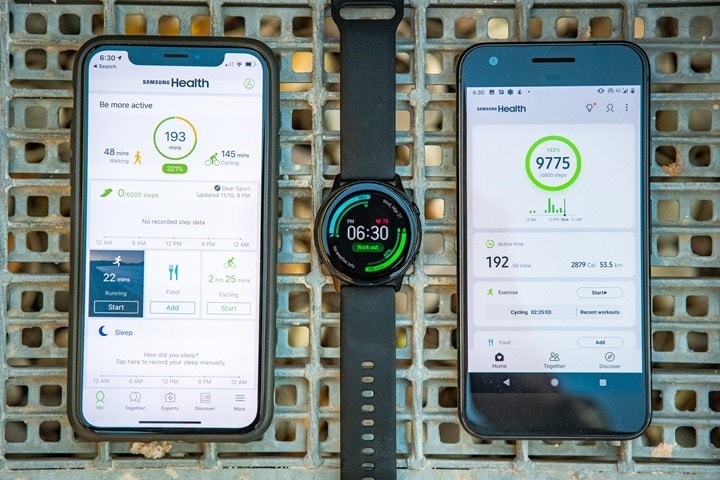

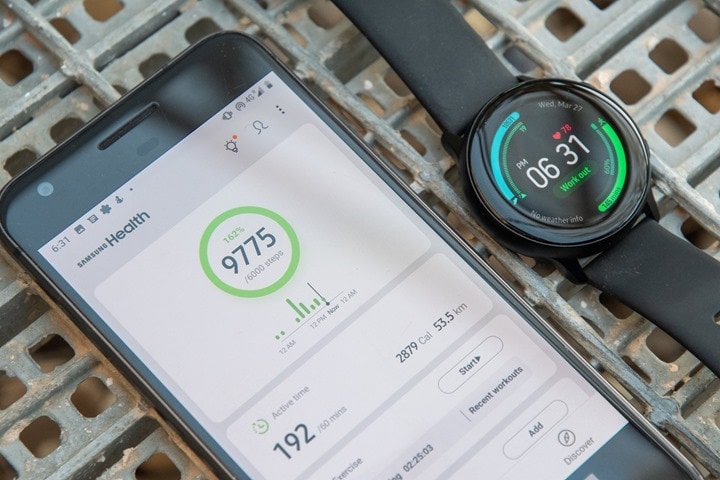
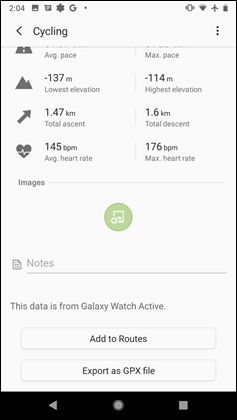
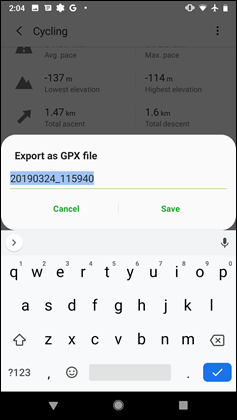
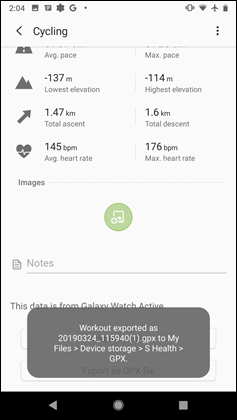
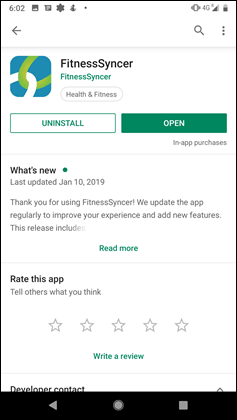

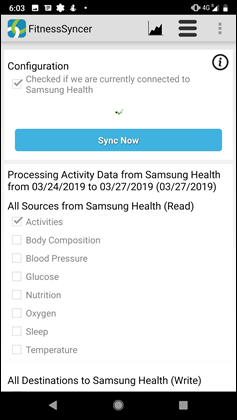


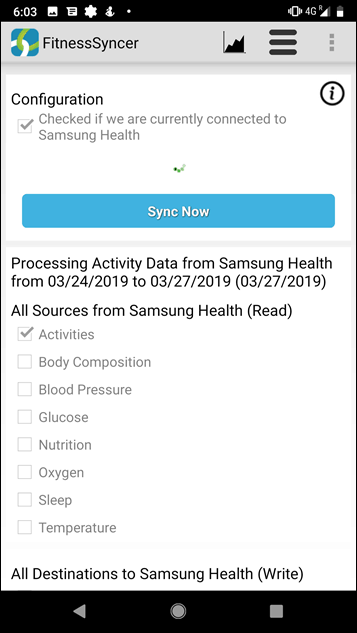


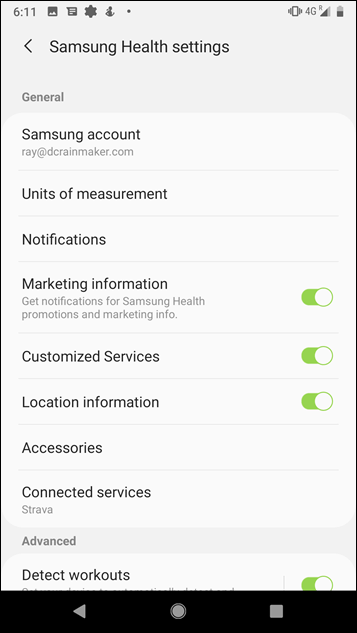
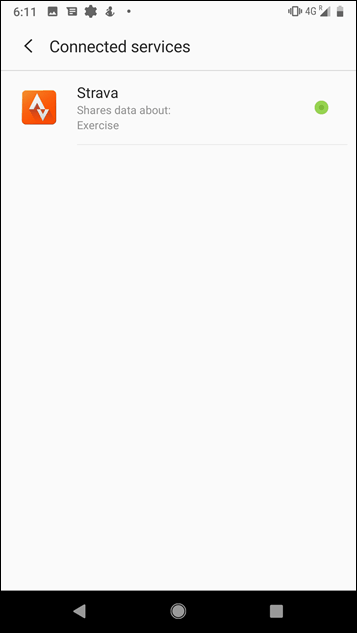
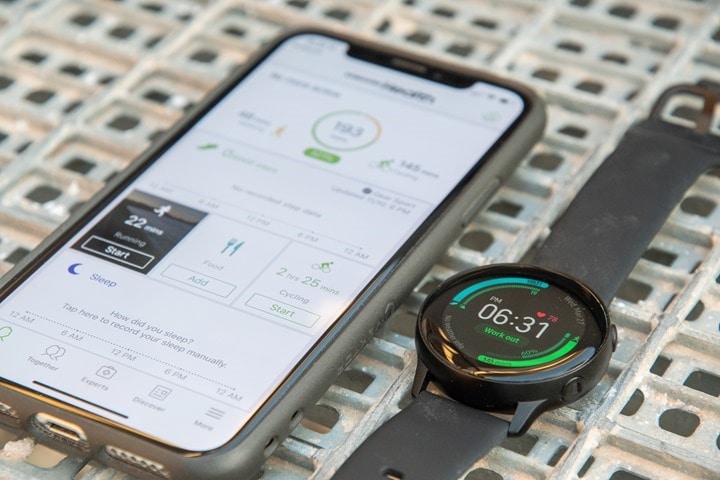

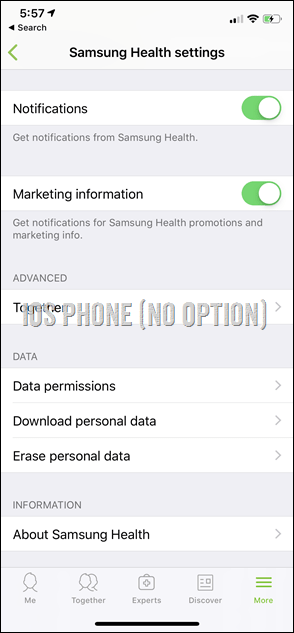
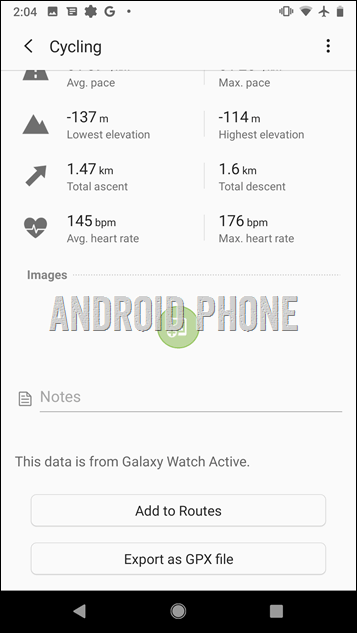
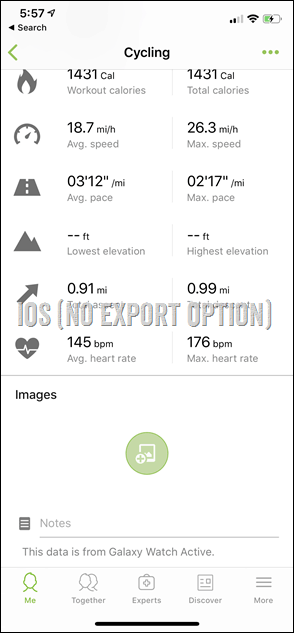
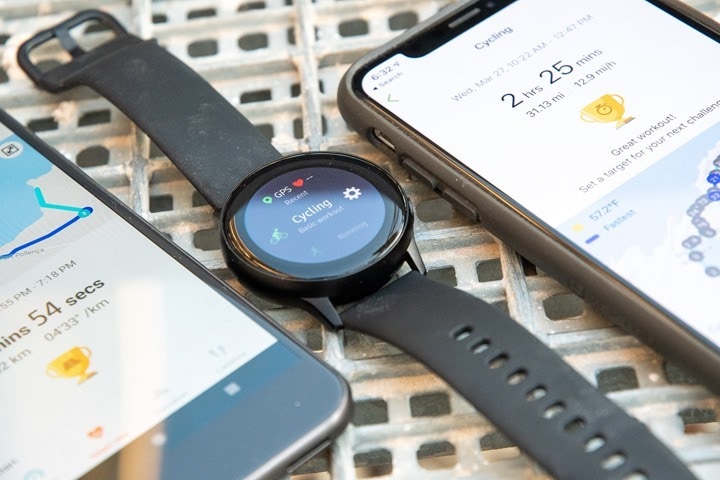

















Hi,
Thanks for all the great work and motivation you give!
Say you get all the data you want to the place you want. What do you do with all that information to make you a better atlet?
Maby a how to guide?
/A
Oh, I’m not asking for something super crazy in terms of information. I just want as an iOS user to be able to upload my workout to Strava or export it so I can upload to TrainingPeaks or any other platform.
It’d also be nice if the unit actually recorded HR at intervals more than one-minute for workouts (funny since it captures at 1-second for 24×7 data).
Uploading the data to Strava through shealth I agree produces strange results. Is much better to use the strava app on the watch. This app its been available since the beginning of the year and avoids potential problems. Why using some other company software in the middle if you can use strava company app directly?
Sorry,
Did not mean to inply you wantet something crazy;).
I wrote under this post i hope of geting an answer.
I mean i generall. If you use a samsung, garmin, apple etc. And you get the data you want. What should you look for in all that data to improve the fitnes of yourself.
If i got all my running data on ex Strava. What do i do with all that data?
Hi Alex. Have you uploaded runs via Strava? I am getting terrible GPS results with multiple dropouts in every session. Its kind of okay on long runs, allthough I get some hickups where I get incredible speed recordins(gps dropout) but on track the app(or watch) is useless. It cuts almost all rounds in the ends, and sometimes cuts over the whole middle field.
This also goes for Endomondo app.
Any similar expiriences, or fixes?
Hi Kjetil, check to make sure you don’t have power saving mode enabled (android). Power saving mode will put your GPS to sleep when the screen turns off.
Alex,
Unfortunately the Strava App for Samsung Watch is glitchy af. It crashes. It won’t sync intermittently. Quite frankly a terrible app.
So some of us are trying to find an easy way to get S Health data onto Strava.
Cheers…
did you happen to sort out this one? I am currently trying to see how I can upload data from Samsung Active 2 watch (Samsung health app) to TrainingPeaks? I have read about SynMyTrack as intermediary app to import from Samsung and export to TrainingPeaks automatically but not sure that is possible and best
the same for how to export from garmin(-connect) would be cool too!
Yeah, though there’s so many ways and it’s so easy/well documented already. On Garmin you can:
A) Just plug the thing in and grab the industry standard .FIT files straight from the Activities folder
B) On Garmin Connect (website), simply click the little gear/settings icon on an activity and choose which format you want to download in.
C) On Garmin Connect (mobile or website), link to a boatload of 3rd parties to automatically have your data sent there. Works on iOS/Android/Mac/PC, and heck, I think even still Windows Phone somehow.
Those are the big three though.
I am just not going to buy any samsung related watches, this is unacceptable!
Hello,
there are actually 2 ways how to get data either straight to strava or download tcx files.
There is one which I am using. It’s watchface called Sporty Watch (You have to download it through Galaxy Store). Once you do and activate it as watchface you can even connect BT chest strap and/or footpods (Stryd and Milestone Pods are supported.)
There is another app called Gear Tracker, but I don’t have experience with this one.
That’s pretty darn cool.
To clarify – in that case (SportWatch for example), that’s acting as an actual workout app – rather than sucking in the data from S Health, correct? So roughly akin to Endomondo in this scenario, but just with more sensor support.
Yep, it completely bypasses S Health. You have 3 options to sync to Strava, Google Drive and Training Peaks (+you can create server from watch and download workouts directly from browser). Only downside is that since it’s watch face you can only use touch navigation (which is lack luster). However, what is really good it looks GPS almost instantly while it takes about 2 minutes for S Health. link to qooapps.com
On the other hand Gear Tracker is an app and seems really cool with lot of customization, but they do not support foot pods yet. link to youtube.com
It is important to add that both of these are paid and costs around 4 euro and I am not sure
… how they will work with iOS.
Hello,
Would you consider this the most smartwatch device you tested? I’m looking forward to the review. From what I saw HR is wacky but GPS isn’t bad.
I think Apple Watch is smarter then this one.
For me, using Endomondo, or Strava app on the watch the GPS is useless. Multiple dropouts every run.
Can you plug it in as a USB device? I realize most things since the Fenix 2 have some kind of wireless sync, but maybe that’s easier?
I don’t have latest Samsung watch, but it’s not possible to do it with Gear S3, so I highly doubt that it would be possible.
Hi Ray, is this the reason we’ve not seen a review for Withings Steel HR Sport? Lack of data extraction? I’d seriously consider it if I could push data to Strava.
Hi Ray,
I would like to share some information that might be helpfull for your in-depth review: I purchased a Samsung Galaxy watch two months ago and was really frustrated by the inaccurate HR monitoring and in particular the many and long lasting dropouts during my workouts.
I believed, if I enabled “Auto HR –> permanent” everything should work, but it didn’t!
Until I found out by chance that there is another option in a place of the watch’s setting, where you wouldn’t it expect to be:
Just take your watch, go to settings –> apps –> permissions –> system apps –> power saving
There you will find out that the power saving mode for sensor (also HR) is enabled by default! From my point of view this is what causes the issues mentioned above and drives every samsung galaxy watch owner crazy who wants to monitor the HR during excercise. I don’t know why Samsung did that but the fact that neither the support forum nor the hotline knows about the solution is even a bigger mystery to me.
However, if you disable this button you will find out that the HR monitoring will work as it is supposed to do. Maybe you can double check and mention it in your review if you make the same experience.
Cheers, Lars
Does turning off power saving mode for HR make it more accurate?
Hi Ray,
perhaps to point out that SyncMyTracks stores and sends the passwords in plain text? (Till now afaik)
Huh – I didn’t know about that. I’ve primarily used FitnessSyncer, not SyncMyTracks.
How is this even considered a viable device given all the hoops you have to take just to get your data into the services you want to use?
Because 99% of the people do not require to export the data in a file in order to make an analysis of the hardware. On this watch you have a dedicated app for Strava, Endomondo and others (besides sheath) which give the necessary data for most users.
On this site, the needs are different. They make a professional comparison between different watches and the requirements are different.
I’d argue that being able to take your activities and history with you to another platform is far more important. If i want to leave Garmin, it is reasonably easy to do so without having to jump through hoops. My experience with the strava app on the Gear S3 wasn’t positive, but potentially it has dramatically improved.
I’m talking about exporting your activities into a file (which is not that common). In my case I use Strava and all my activities are recorded there. I can change to any platform without issues (garmin, apple..).
I forgot to mention that the strava app had already 3/4 updates and does its job correctly. Of course I did not make any comparison versus other watches so I cannot say if GPS accuracy is good or not. Results seemed normal to me but I’m not an advanced user. That is why I’m looking to read a professional review here!!
Instead of a friend with an Android device, perhaps you could get by with an Android emulator on a regular computer. E.g. https://www.bluestacks.com
Can you fake a SIM in that? S Health won’t install without a SIM in the phone (learned that bizzare lesson earlier this week.)
I’ve been a Fitness Sync user for awhile and it’s a great tool to make sure my data from various sources all end up in Training Peaks. Easy enough to use, supports lots of sources, and can actually do some filtering of data and selective uploads. A good hub to get fitness data from and to multiple sources.
Vaguely related is tapiriik dead? This made me think to check my dropbox and Tapiriik hasn’t synced anything to it for quite awhile.
I’m not sure on Tapiriik – I haven’t heard much either recently.
I’m confused why you wouldn’t just use the native Strava app on the watch. Wouldn’t that be the better experience and give you all the functionality you want? But the watch for the hardware and the platform, not for the built in apps. I mean I don’t complain how the wahoo fitness app isn’t that good of an app to control my kickr, I bought the kickr for the hardware and use other apps to control it
I try and use the default apps as much as possible for review reasons, since especially with GPS – differing apps can result in differences on accuracy due to processing/etc.
Also, for Strava, it doesn’t support that many sports. For example – I can’t use that for swimming.
So giving buying advice based on a built-in app that isn’t good instead of setting up it like someone who really bought the device and wanted it to work as well as they could get it to work? Granted that makes it way harder to test it with so many variabilities…
As noted, some sports – swimming for example – is only support in the Samsung app. So, yeah.
And I think a lot of folks do use the default apps, especially on the Samsung device. That’s because they have direct links from the stock watch faces as well as also show up properly on Samsung Health. Further, unlike iOS, Samsung actually shows some of these health stats on the home screen of devices, making it even more compelling to use the stock apps.
Finally, as you noted – if I used 3rd party apps for all my testing and then found variability with 3rd party apps but had blammed Samsung for crappy GPS or crappy HR, not sure how that’s fair. Ultimately, any company (Samsung, Apple, Garmin, whomever) lies in the bed they made. If they made a crappy 1st party experience, that’s on them to address. There’s no excuse for not having the basics working.
I’m trying to figure out how to sync my data from my Fitbit to Google Fit. Step counts, HR, and sleep are what I’m needing. The activities/ workouts aren’t a concern because that syncs to Strava which goes to my health rewards program already. Why does all of this have to be so complicated? My rewards program is RedBrick.
Does it work seamlessly from watch to strava? Because after that I can do a lot from Strava, like pair Strava to TrainingPeaks.
Sorta. I haven’t spent a ton of time with that app, mostly using Endomondo instead.
Is your GPS results accurate or do you see multiple spikes in your runs too?
Have you tried health sync? It syncs Samsung health with google fit. It has some problems related to step syncing but it works for the rest.
Thanks for this….I think. While Samsung Fitness is connected to my Strava account, all workouts come into Samsung Health as Other (except for walking). Thus all of the Strava data (HR, Speed, cadence, power, etc.) from a cycling workout will appear in Samsung Health, but not be categorized as cycling. To add insult to injury, it often takes 1-3 DAYS for workouts to appear from Strava into Samsung Health. As far as I know, none of the other Samsung Health data (Food, steps, sleep, etc.) is usable outside of the Android app. So ….why use it?
I think Samsung have updated their health app recently. I don’t get any option to export a file when viewing an activity. It looks the same as your screen shot of the iOS device.
I’m using s10+ btw
Woah, that’s weird. And I presume that’s an outdoor run with a GPS track?
Yeah it was an outdoor run, but there’s something weird about it. In the Samsung health app it shows all the usual stats like total distance, time & pace for each km heat rate etc, but there’s no map. I used FitnessSyncer and transferred it to Strava and it only copied across very basic information like total distance and total time. None of the other data has transferred.
This thread also had other users complaining about the s health app missing the export to gpx option, plus a load of other sync complaints about strava:
link to eu.community.samsung.com
So someone on my Samsung Galaxy Active review noted something in that rough ballpark in the comments, whereby there was no GPS track as well. I think something in a recent update must have dorked up the GPS permissions, where it’s not plotting tracks.
Obviously, without a GPS track you can’t export a .GPX. Chicken and egg thing. Sigh…
Just thought I’d add another 3rd party app into the mix.
Run4Gear seems pretty good. It’s free. It has a multitude of automatic export functionality.
Tracks Cadence along with Heart rate which is something the builtin apps don’t do.
Has some built in interval training fucntionality also which is nice.
Hi there!
I faced the same problem, and in search of a solution I wrote a small script to convert the json data from com.samsung.health.exercise directory, where the files are saved after exporting personal data, to the GPX file for Strava. I will be glad if it helps you too.
You can see details there: link to github.com and try online here: link to hitlife.net.ua
If you encounter problems – write to me here, I will try to help
Wow.. i don’t know how to thank you.. Your code it’s perfect and work very well for me. I sync strava and S-health but there were some workout that miss the sync.. Thanks a lot!
.
Hi,
I’m not a techy sort of person and hate complexity! And I get this could be an overly simplistic observation/solution! But I’ve just installed strava on my new active 2 watch, and will start my run using that app. It should bypass the samsung heath app (I think) and transfer the data straight to strava on my phone. Or am I missing something?!
You can install MapMyRun on Android and link that with Samsung Health from inside MapMyRun.
MapMyRun will appear afterwards in Samusng Health -> Settings -> scroll down to Data Permissions
The best way is to sync your tracker to samsung health app and download you data from Samsung Health settings option. You will get all your activity log in csv files easy to open in excel.
While easy to open in Excel, it’s useless for any other app on the planet as sports-specific data. Unless a workout is exported into one of the couple different industry standard sports formats (.FIT, .TCX, or .GPX in some certain cases), it’s mostly no better than trying to redeem Monopoly money in real life.
I absolutely agree with all your arguments. I discover this at worst way…. because I recently migrated from the Galaxy S8 to iphone, and thought I would bring my galaxy watch with its features, unfortunaly it was a complete disappointment. I never thought of selling a kidney to buy an Apple Watch, not least because it horrible, compared to the GW design. But it seems that Samsung has no interest in providing a complete experience for its users in the world of the apple.
The option export as GPX file is no longer visible (available) in Samsung Health. How come?
Same here in September 2020 … No GPX Export function available. I’m thinking of sending back the watch …
Problem solved by setting all GPS options to “yes” and re-install the app.
Good day i’m wondering if you can help me get accurate data on to strava from shealth, i use the shealth connected services currently but as you mentions the metrics are horrible and make it seem that i am a super efficient runner. id just like accurate results to show on strava while i continue to record my runs with my galaxy watch. is there an export method with the GPX file that i can use to get it to correctly show my data on strava?
thanks in advance
Just wanted to say same! WTF?
Thanks for the info. About to get a Samsung watch (galaxy 3). Any way to get the file from s-health and change he file name to get out into my Nike run club account?
Great
It costs a lot of hours until i find your tutorial
Thanks for dispose your time and share your knowledge
Regards
Andre Palacios
Hi, thank you for your answer on the other thread, I have yet to test your software so I’ll see when I do it.
However I was wondering something : I have a Samsung Watch Active 2, I managed to export some data through sync with Strava or through Google Fit, however there’s a big parameter always missing : the ground contact time. It appears in S-Health in a graph, however I can’t get the full data i any of the file I succeeded to export. Do you or anyone else have a solution for this ? The Smasung support platform isn’t working these days so I can’t ask there, and I didn’t find any other solution on the web.
Thanks,
After my Samsung Gear Fit 2 Pro got stuck in a boot loop and proved irreparable via software means (updating it with older firmware via Odin), I decided to get a garmin GPS watch and export my data to Garmin Connect.
About path B: I wanted to seamlessly export all data, but using strava as a “middleman” app didn’t work because the transfer apps taking the data there were so disappointing:
Unfortunately, “fitness syncer” isn’t available for Android 6 phones any more.
“Health sync” only syncs the current and future workouts to Strava (at least in July 2021) – something that Samsung health can already do on its own (but only with current and future workouts too).
So I chose path A: Pushing “export” in every single workout sheet, where this was possible. That was a heap of work – though I didn’t care about the HR data since I had only had my used gear fit 2 pro for half a year. Importing the gpx files in Garmin Connect was really easy. Still, I had to manually type in those automatically generated workouts (such as walks) that couldn’t be exported. This has kept me busy for quite a while.
Now that the only remaining data are sleep times, I think I’m going to give up here. I had read that you can import sleep files to Garmin Connect from fitbit and tried to migrate the sleep data over there first. The problem was getting it there: Just like earlier, with the “health sync” app, you can only transfer (current) sleep times to fitbit.
Another way would be to type in all the individual data. There’s just some problems here: You can only manually add sleep data in the Garmin Connect App – not in the browser version, which makes it quite tedious. Furthermore, I’d like to warn those who try: If you download your personal data from the Samsung Health app, access it on your computer and open the “com.samsung.shealth.sleep…” in Excel, the start and end times seem to be wrong! I compared them with the app times, and all entries from April 1st 2019 on are stored two hours earlier: Instead of the correct app time of 10pm, the data file says 8pm. For all entries up until February 28th 2019, the times are stored one hour earlier: Instead of the correct app time of 10pm, the data file says 9pm.
Ray, your description was helpful, and your youtube channel is great too, but I’ll be glad once I can finally get rid of all this Samsung Health stuff.
Thank you so much. I have been using both for forever. It’s nbd on my morning runs. But Strava eating my battery + using a mapping app on my phone starts to really eat my phone battery. Being able to get the Strava details through my watch will make a huge difference.
After installing Samsung Health on your iPhone, simply go to Settings->Health (the Apple one)->Data Access & Devices, and the Samsung Health App should appear their under Apps as a potential source.
You can turn on the options you want to Sync. The data will be synced between both Apps, and so your data will be available at your Apple’s own Health App.
So it seems FitnessSyncer (and other 3rd party apps?) can only work through Samsung Health app, right? It could be helpful to reflect this on your graphical overview…